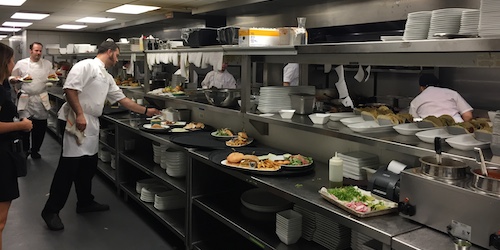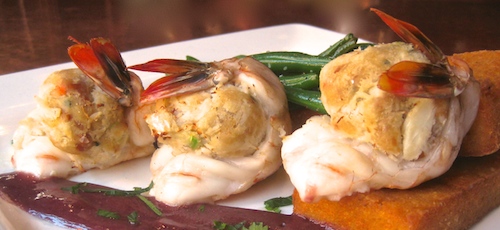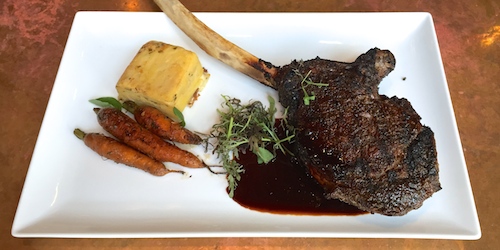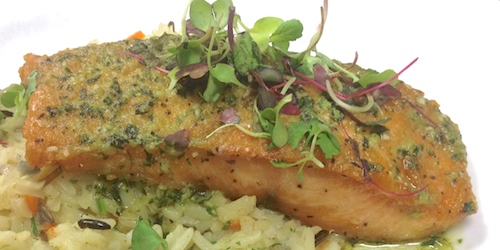Our Chef Terminology glossary allows you to brush up on your chef and kitchen vocabulary, from cooking techniques to preparation and serving tips. Suggest additions in the comments and we will add them to this list.

The A-Z of Chef Terminology
Al dente
The literal translation from Italian is “at the tooth”, and refers to the perfect texture for cooking pasta, where the pasta still has a little firmness and ‘bite’ to it.
Amuse bouche
This refers to small, bite-size concoctions of food, which the Chef can present to their guests before the regular courses of the meal begin. The translation means “to amuse the mouth”.
Au gratin
Where a dish is sprinkled with grated cheese or breadcrumbs, and then browned.
Au jus
This is French for “with juice”, and means that the food item will be served with its natural juices (often referring to beef).
Basting
A cooking technique that involves brushing or coating meat in its juices or an accompanying sauce. This helps keep the meat moist and is especially useful when the meat is over heat for longer time periods, such as grilling a rack of ribs or roasting a turkey in the oven.
Blind Baking
When pastry is baked before adding a filling.
Blanching
Where food is submerged in boiling water very briefly, then removed and plunged into iced water to halt the cooking process.
Braising
A cooking method where the food is seared at a high temperature for a short period of time, then cooked fully in a pot with liquid/other flavorings/ingredients.
Brining
A food is soaked in salted water brine, usually to preserve it, or to enhance the flavor before cooking.
Broiling
A US term that refers to cooking with a heat source that is above the food, as opposed to grilling, which is when the heat source is below the food.

Butterfly Shrimp stuffed with Crab (South Branch Tavern & Grille, Chicago)
Butterfly
To split a food in half but not cut the entire way through, instead folding out in a butterfly shape. This exposes more surface area to the heat source and helps the food cook evenly and quickly.
Coddling
This is when food is heated in water to just below the boiling point.
Crimp
Where the edge of one or more pieces of dough is pinched together to seal together and form a decorative edge.
Deglaze
After food has been cooked in a pan, a stock or other liquid can be added to the empty vessel over high heat, and the bottom of the pan is gently scraped to release any flavor and color that is stuck to the bottom.
Double steaming
This is a Chinese cooking technique where food is immersed in water, and put into a jar, which is then steamed for several hours.
Fermentation
In addition to being a step in the brewing process of beer, this term can also be used in culinary situations to mean a preservation technique where sour foods can produce lactic acid in order to stay edible.
Fricassee
This is a way to cook meat that involves chopping it up, sautéeing, braising, and then serving it in its (traditionally white) sauce.
Ganache
A combination of cream or milk, mixed with melted chocolate, creates a soft consistency that does not re-set when cooled.
Julienne
A way to cut foods into long thin strips, similar to ‘shoestring fries’.
Kneading
When making bread or pasta dough, the mixing of water and flour creates a chemical reaction that gives texture and firmness to the dough, and it is necessary to knead the mixture by stretching and folding several times over, creating an elastic and smooth dough to then shape and work with.
Lame
An instrument that is used to score and cut the tops of bread loaves in artisan baking.

The Maillard Reaction shown on a Tomahawk Steak (Howells & Hood, Chicago)
The Maillard reaction
The chemical reaction in food items between the amino acids and sugars when heat is applied. The reaction causes that dark, rich flavor as well as the browning of meats, the darkening of baked goods, and the golden color of french fries.
Marinating
This is when foods are soaked in a liquid or sauce before cooking (often overnight) in order to enhance flavor, but the process will also help tenderize a piece of meat.
Mise en place
A French phrase meaning “putting in place”, which refers to the setup that a Chef will have in their workspace in a professional kitchen. The time spent organizing ingredients and tools will allow a chef to plate a dish at rapid speed during a busy shift.
Omakase
A Japanese term, whereby ordering means that the chef will choose the food items to be served. The literal translation means “I trust the chef.”
Pasteurize
This process sterilizes milk by heating and then rapidly cooling it.
Poaching
When foods are gently simmered in a liquid.
Purée
A purée is a fine mixture that is created by blending and/or sieving foods in order to remove lumps and seeds and other elements.
Rotisserie
This describes when meat is skewered on a long rod and suspended over a fire or in an oven.
Roux
A mix of flour and oil/butter which is heated, and can then be used to thicken sauces and gravies.
Sautée
From the French word that means “to jump,” and means to lightly fry food in a small amount of fat, over high heat until golden and tender.

Pan-Seared Salmon (Sweetwater Tavern, Chicago)
Searing
A cooking technique where the surface of the food is cooked at high temperature in order to form a brown, caramelized outside. The food is then often finished by grilling, braising, or roasting.
Service à la française
A traditional 19th Century service practice that you may see at formal dinners, where all the food for each course is brought out at once.
Sprouting
With a small amount of moisture, a seed will begin to germinate and sprout, forming a small seedling version of its full plant self.
Truss
This is when meat is tied up with wooden or metal skewers in order to keep its shape while cooking.
Whip
To incorporate air into an ingredient (eggs, cream, etc.) by rapidly beating in a bowl and adding volume until the desired consistency is reached.
Zesting
A technique where small pieces of the peel of colored citrus fruit are removed.
